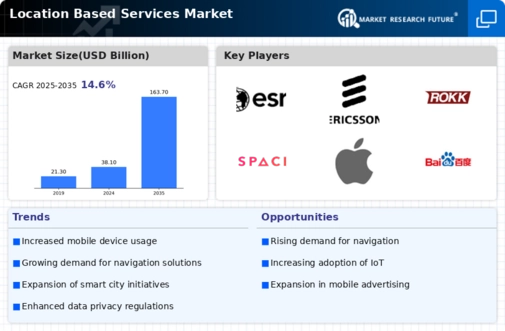Market Growth Projections
The Global Location Based Services Market Industry is poised for substantial growth, with projections indicating a market size of 38.1 USD Billion in 2024 and an anticipated increase to 163.7 USD Billion by 2035. This growth trajectory suggests a compound annual growth rate of 14.17% from 2025 to 2035. The increasing adoption of location-based technologies across various sectors, including retail, transportation, and healthcare, is likely to drive this expansion. As organizations recognize the strategic advantages of leveraging location data, investment in innovative solutions is expected to rise, further propelling the market forward.
Advancements in IoT and Smart Devices
The rapid advancements in the Internet of Things (IoT) and smart devices are reshaping the Global Location Based Services Market Industry. As more devices become interconnected, the demand for location-based data increases, enabling smarter decision-making across various sectors. For instance, smart home devices utilize location data to enhance user experience and energy efficiency. The integration of location services in IoT applications is expected to foster innovation and create new opportunities for businesses. This trend may lead to a compound annual growth rate of 14.17% from 2025 to 2035, as organizations increasingly adopt location-based solutions to improve their operational capabilities.
Rising Demand for Navigation Services
The increasing reliance on navigation services is a primary driver of the Global Location Based Services Market Industry. With the proliferation of smartphones and GPS-enabled devices, consumers expect accurate and real-time navigation solutions. In 2024, the market is projected to reach 38.1 USD Billion, reflecting a growing trend towards mobile navigation applications. Companies like Google and Apple continue to enhance their mapping services, integrating features such as traffic updates and route optimization. This demand is expected to escalate further, as urbanization increases and more individuals seek efficient travel solutions, thereby propelling the market forward.
Growth of E-Commerce and Delivery Services
The expansion of e-commerce and delivery services significantly influences the Global Location Based Services Market Industry. As online shopping becomes increasingly prevalent, businesses require precise location data to optimize delivery routes and enhance customer experience. The integration of location-based services allows retailers to provide real-time tracking and efficient logistics management. This trend is likely to contribute to the market's growth, with projections indicating a rise to 163.7 USD Billion by 2035. Companies leveraging these services can improve operational efficiency, reduce delivery times, and ultimately enhance customer satisfaction, thus driving further investment in location-based technologies.
Emergence of Smart Cities and Urban Planning
The emergence of smart cities is a significant factor influencing the Global Location Based Services Market Industry. Urban planners and governments are increasingly utilizing location-based services to enhance city infrastructure and improve public services. By integrating location data, cities can optimize traffic management, public transportation, and emergency response systems. This trend is likely to drive investment in location-based technologies, as cities strive to become more efficient and sustainable. The focus on smart city initiatives is expected to contribute to the overall growth of the market, as governments and private sectors collaborate to implement innovative solutions that leverage location data for urban development.
Enhanced Marketing Strategies through Geolocation
The utilization of geolocation in marketing strategies is a pivotal driver of the Global Location Based Services Market Industry. Businesses are increasingly adopting location-based advertising to target consumers more effectively. By leveraging geolocation data, companies can deliver personalized promotions and advertisements based on a user's current location. This approach not only enhances customer engagement but also drives sales conversions. As businesses recognize the value of location data in refining their marketing efforts, the market is likely to experience substantial growth. The increasing sophistication of data analytics tools further supports this trend, enabling businesses to optimize their marketing strategies based on real-time location insights.





















Leave a Comment